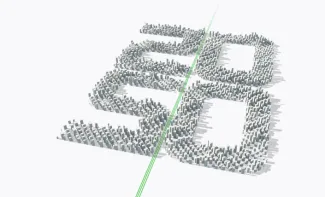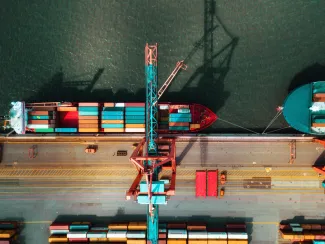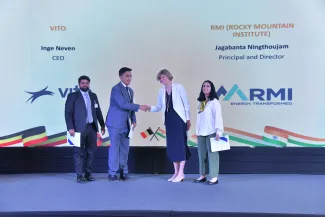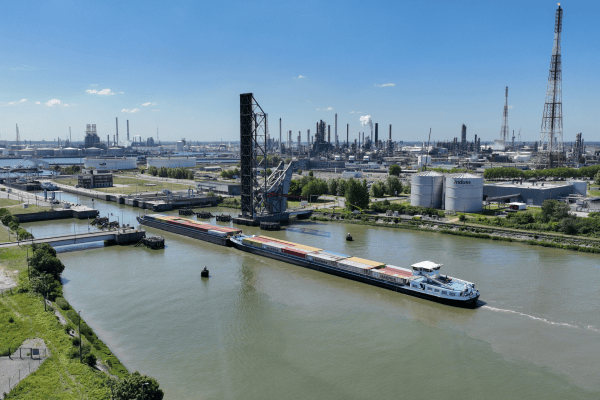Industrial decarbonisation matters
The global energy transition is accelerating, yet it comes with a sharp rise in demand for critical materials and clean energy solutions. Without action, supply shortages, carbon-intensive production and limited socio-economic benefits for development of countries could undermine climate progress.
From molecules to markets
VITO integrates policy support, capacity building and pilot demonstrations to show how industrial zones can generate renewable energy, improve efficiency and share benefits with surrounding communities. Our approach is practical: strengthen regulatory frameworks, build technical capacity and mobilise investments to create business models that work for industry and society alike.
Global and African relevance
Africa’s industrial trajectory will influence global supply chains and climate targets. By supporting local value addition, skills development and fair partnerships, VITO helps transform resource wealth into sustainable prosperity. Demonstration projects in South Africa can serve as blueprints for other regions facing similar industrial and energy challenges.
Join us in turning today’s challenges into shared opportunities for a just and green industrial future. We are looking for public and private partners to pilot and scale solutions. Let’s collaborate across borders and sectors to accelerate circular, low-carbon industry.
How VITO drives industrial decarbonisation
VITO plays a central role in industrial decarbonisation and Power-to-X (PtX) or ‘clean molecules’ through its EnergyVille partnership and several specialised research teams. Our approach builds on five key strengths:
- Industrial decarbonisation expertise
Developing pathways to cut emissions in energy-intensive industries through efficiency, electrification, circular raw materials and renewable integration. - Clean molecules & Power-to-X
Positioning hydrogen, ammonia, methanol and synthetic fuels where they bring real system value: in industrial feedstocks and international energy trade. - Innovative methods
Combining advanced modelling (e.g. PATHS2050 together with key players in the Belgian energy system), circular economy approaches and international best practices to design scalable business models. - Potential impact
Strengthening energy security, cutting emissions and reducing raw material dependency, while building global partnerships that drive inclusive growth.

A road map for decarbonisation

Energy system modelling & pathway development
VITO, through EnergyVille, leads PATHS2050 with major industry partners to design roadmaps for climate-neutral industry. Scenarios explore renewables, clean molecules, SMRs and carbon capture to keep industry resilient while cutting emissions. Read more
In the CEEP-IT project, VITO/EnergyVille connects energy system optimisation with macro-economic and input–output modelling to deliver realistic projections of industrial energy demand and transformation impacts. Read more

Carbon Capture, Use & Storage (CCUS)
VITO develops advanced porous sorbents for efficient CO₂ capture and investigates the use of captured CO₂ in new value chains. Applications include building materials, chemicals, fuels and polymers. A concrete example is Carbstone: carbon-negative paving stones produced by reacting steel slag with CO₂. Read more

Ports & industrial clusters
Ports are key enablers of industrial decarbonisation. For the Port of Antwerp-Bruges, VITO explored how to replace fossil-based feedstocks in the chemical cluster with recycled and bio-based carbon. This approach promotes chemical recycling and bio-based sources to enhance both sustainability and resilience in one of Europe’s largest industrial hubs. Read more

Green hydrogen
Hydrogen and its derivatives are essential elements in the clean molecules strategy. VITO works on the technical, economic and systemic aspects of green hydrogen production and use, identifying where hydrogen brings the most system value, from industrial feedstocks to international energy trade.
Transforming CO₂ emissions into feedstock for the chemical industry
The EU Horizon 2020 project VIVALDI has demonstrated a pioneering methodology to capture, purify and convert CO₂ emissions from bio-based industries such as food, pulp and paper into valuable organic acids. By combining electrochemical and biotechnological processes, the consortium developed a sustainable pathway that reduces industrial carbon footprints while promoting circular production.
VITO is mainly involved in the electrochemical conversion of CO₂ emissions, with responsibility for electrode development and processes that transform captured CO₂ into methanol and formate. These building blocks can then be used to produce higher-value organic acids, opening new opportunities for circular chemistry and reducing reliance on fossil feedstocks.

Partnerships make it happen

Agfa and VITO: boosting green hydrogen innovation
VITO collaborates with Agfa to develop next-generation separator membranes for alkaline electrolysis, accelerating the scale-up of green hydrogen production.

Green hydrogen partnerships between India and Belgium
VITO shared expertise during high-level talks in New Delhi, strengthening international collaboration on hydrogen storage, transport and industrial applications.
Let’s accelerate net zero
VITO develops practical pathways for industrial decarbonisation and clean molecules. Feel free to contact our experts for more information.






